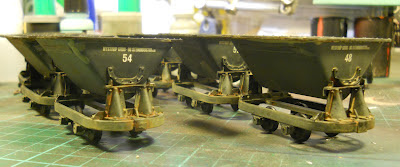At the moment a lot of civilian cars are coming out from the large manufacturers of military models. Both Tamiya, Bronco and ICM have released cars that have ended up on my shelves (mostly awaiting assembly). As I write these lines, I see news of yet another
Opel from ICM. This is one more reason I'm glad that I model in 1:35 scale. So much to choose from!
To many people at model railway exhibitions cars are more 'era defining' than the trains. Cars and lorries on my layout thus carry a large burden - defining the setting as 'first half of the 1950´s'. The Kapitän is an ICM kit of what the company calls a 'Kapitän Saloon, WWII German Staff Car'. See the kit's layout on
Armorama and
Wikipedia.de on the Kapitän. There is no military fittings so the car can be used in a non-military role without any rebuilding. The car is a typical ICM kit with a lot of small parts. The layout of parts is not without issues, as the upper body has to be assembled from many parts. This does not make the assembly/painting sequence easy to plan. Until now the worst issue I have found is the fit of the headlight/radiator grill assemby. It needs quite a lot of filler and sanding to blend in.
 |
| Basic chassis constructed. Only the most basic parts of the engine was used. I see no point in detailing an engine that can't be seen when the model is finished. The unused parts went into my collection of spare parts. Never throw anything away! Photo from before I added the bad fitting front part. |
In the early fifties a lot of cars in Denmark were still pre-war models. Even those who were well off didn't have easy access to new cars, due to tight import restrictions. The director of Nystrup Gravel, Jørgen Holm, still drives his 1939 model Opel Kapitän. His car was moth balled during the war and although being from 1939 hasn't seen much use. Director Holm fancied a new American car, but didn't get permission to buy one. Holm wasn't alone. In 1949 not a single American car was allowed to be imported into Denmark. To most Danes the price of an American car was prohibitive anyway.
The model is surprisingly large and will fit the status of director Holm very well. A respected man and conservative member of the city council needs a respectable car.
See progress on the car on this
newer blog post



















